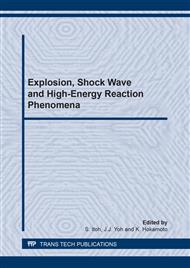p.173
p.179
p.185
p.191
p.197
p.203
p.209
p.215
p.219
A Numerical Research on the Penetration into a Semi-Infinite Rolled Homogeneous Armor by a Medium-Caliber Kinetic Energy Projectile
Abstract:
This paper presents numerical analysis on the penetration into a semi-infinite Rolled Homogeneous Armor(RHA) steel target by a medium-caliber projectile at the velocity range from 900m/s to 1000m/s. The projectile was made of a 93% tungsten heavy alloy(WHA) having a diameter of 18mm. LS-DYNA, an explicit non-linear finite element analysis code, was used for the numerical analysis. This kind of penetration problem is generally accompanied by large deformation, high strain rate and thermal softening, accordingly the Johnson-Cook constitutive models combined with Johnson-Cook fracture model and Mie-Gruneisen equation of state were employed to describe the RHA target and the WHA projectile, respectively. Due to the lack of the parameters of the Johnson-Cook failure model of RHA, the corresponding data of 4340 steel were applied for RHA inevitably. Here, two different failure strains for 4340 steel from the literatures were substituted in for RHA and their effects on the numerical analysis results were discussed and compared to the test results in terms of penetration efficiency(P/L) and crater hole shape. A quarter parts of the semi-infinite RHA target and the WHA projectile were only modeled considering the symmetric configuration of the problem for the analysis.
Info:
Periodical:
Pages:
197-202
Citation:
Online since:
January 2011
Authors:
Price:
Сopyright:
© 2011 Trans Tech Publications Ltd. All Rights Reserved
Share:
Citation:


